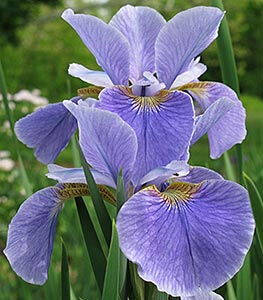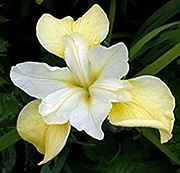Siberian iris (Iris sibirica): few perennials are as accommodating and beautiful as while requiring so little work from the gardener.
The flowers are delicate, having only 6 petals, but flutter in the breeze atop 24 to 36 inch stems. Each stem produces 2 to 5 flowers, each about 2 inches wide.
The flowers bloom in shades of blue, purple, violet, yellow, white or cream, and there are hundreds of cultivars to choose from.
Adding to the glory of the early season garden

Early-flowering Iris sibrica ‘China Spring’
Photo: TieGuyII, Flicker
Siberian iris begins to bloom in that gorgeous period of mid- to late-spring when bearded iris, peonies, alliums, oriental poppies and foxgloves are also flowering.
The plants grow 2 to 3 feet tall. The foliage is narrow and sword-like, and stays handsome all season, turning yellow in fall before being flattened by frost.
If you don’t deadhead, the seed pods remain upright, adding winter interest.
Iris sibirica care
The level of care is easier than for bearded iris, as these perennials are seldom bothered by iris borers and soft rot, which can plague bearded types.
Where to grow: Hardy to Zone 3; in the south to Zone 8, as long as the soil is not alkaline. Give them full sun if you garden in the north. In the south, they prefer part shade.
Division: These plants grow from rhizomes – a type of horizontal underground root stock from which shoots grow upward and roots descend. You don’t need to divide the clumps until you start getting fewer flowers. (Information on dividing perennials is here.)
Transplanting can be done in either spring or late summer. The only hard and fast rule is that you need to water well for at least a month after planting, but avoid standing water around the roots.
Dividing an established clump will take a bit of strength, as the roots and rhizomes grow thickly together. When replanting, place divisions 2 to 3 inches deep into fertile, moisture-retentive soil with an acid to neutral pH.
Choosing cultivars:

Siberian iris ‘Butter and Sugar’
Photo: Missouri Botanical Garden
Hybridizing has provided more variety of color, form, size and length of bloom.
The first tetraploids (double the number of normal chromosomes) became available 1970. They have larger flowers and thicker stems and leaves.
A few choice cultivars include: ‘Butter and Sugar’ (yellow and white); ‘Caesar’s Brother’ (dark violet blue); ‘Fourfold White’ (tetraploid clear white); ‘Mildred Peck’ (lavender-pink); ‘Perry’s Blue’ (sky blue).
Most garden centers carry just a few cultivars. If you’re looking for newer introductions, the Society for Siberian Irises (link opens in new window) has good information and a list of suppliers.
-By Sandy Perry, a Michigan-based retired horticulturalist and avid gardener





